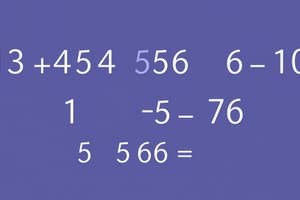Podcast
Questions and Answers
What does the discriminant of a quadratic equation tell us?
What does the discriminant of a quadratic equation tell us?
- The exact values of the roots
- The sum of the roots
- The product of the roots
- The type of roots (real and distinct, real and equal, or imaginary) (correct)
The quadratic formula can only be used when the quadratic equation is written in standard form.
The quadratic formula can only be used when the quadratic equation is written in standard form.
True (A)
What is the standard form of a quadratic equation?
What is the standard form of a quadratic equation?
ax² + bx + c = 0
The sum of the roots of a quadratic equation can be found using the coefficient of x, and is represented by the formula: __________.
The sum of the roots of a quadratic equation can be found using the coefficient of x, and is represented by the formula: __________.
Match the following methods with their associated characteristics:
Match the following methods with their associated characteristics:
Which of the following sets includes only whole numbers?
Which of the following sets includes only whole numbers?
All rational numbers can be expressed as a fraction of two integers.
All rational numbers can be expressed as a fraction of two integers.
What is the degree of the polynomial 5x^3 + 2x^2 - 4?
What is the degree of the polynomial 5x^3 + 2x^2 - 4?
The expression 3x^2 + 4x - 5 is an example of a ______.
The expression 3x^2 + 4x - 5 is an example of a ______.
Match the following types of polynomials with their definitions:
Match the following types of polynomials with their definitions:
Which of the following is a correct form of a linear equation?
Which of the following is a correct form of a linear equation?
The zeroes of a polynomial can be found through graphical methods.
The zeroes of a polynomial can be found through graphical methods.
What relationship exists between the zeroes and coefficients of a quadratic polynomial?
What relationship exists between the zeroes and coefficients of a quadratic polynomial?
Flashcards
Rational Numbers
Rational Numbers
Numbers that can be expressed as a fraction p/q, where p and q are integers, and q is not zero.
Irrational Numbers
Irrational Numbers
Numbers that cannot be expressed as a fraction of two integers.
Polynomial
Polynomial
An expression of variables and coefficients using addition, subtraction, multiplication, and non-negative integer exponents.
Degree of a Polynomial
Degree of a Polynomial
Signup and view all the flashcards
Linear Equation
Linear Equation
Signup and view all the flashcards
Solving a Linear Equation
Solving a Linear Equation
Signup and view all the flashcards
Real Numbers
Real Numbers
Signup and view all the flashcards
Zeroes of a Polynomial
Zeroes of a Polynomial
Signup and view all the flashcards
Quadratic Equation
Quadratic Equation
Signup and view all the flashcards
Methods to Solve Quadratic Equations
Methods to Solve Quadratic Equations
Signup and view all the flashcards
Discriminant
Discriminant
Signup and view all the flashcards
Unique Solution
Unique Solution
Signup and view all the flashcards
Quadratic Formula
Quadratic Formula
Signup and view all the flashcards
Study Notes
Number Systems
- Natural Numbers: Positive integers, starting from 1 (e.g., 1, 2, 3, ...).
- Whole Numbers: Natural numbers plus zero (e.g., 0, 1, 2, 3, ...).
- Integers: Whole numbers and their negative counterparts (e.g., ..., -3, -2, -1, 0, 1, 2, 3, ...).
- Rational Numbers: Numbers that can be expressed in the form p/q, where p and q are integers and q is not zero (e.g., 1/2, 3/4, -5/7).
- Irrational Numbers: Numbers that cannot be expressed as a fraction of two integers (e.g., √2, π).
- Real Numbers: The set of all rational and irrational numbers.
- Properties of Real Numbers: Commutative, associative, distributive properties.
- Sets of Numbers: Understanding the relationships between natural, whole, integers, rational, irrational, and real numbers (e.g., natural numbers are a subset of whole numbers, which are a subset of integers, etc.).
- Representation on Number Line: Visualizing numbers on a number line and understanding ordering.
- Decimal Representation: Converting between fractions, decimals, and percentages.
- Operations on Real Numbers: Addition, subtraction, multiplication, division, and exponentiation.
- Square Roots and Cube Roots: Finding the square and cube roots of numbers.
- Approximations: Understanding and using approximations when dealing with irrational numbers.
Polynomials
- Definition: An expression consisting of variables and coefficients, involving only the operations of addition, subtraction, multiplication, and non-negative integer exponents of variables.
- Types of Polynomials: Monomials (one term), binomials (two terms), trinomials (three terms), etc.
- Degree of a Polynomial: The highest power of the variable in the polynomial.
- Value of a Polynomial: Evaluating a polynomial for a given value of the variable.
- Zeroes of a Polynomial: Values of the variable for which the polynomial evaluates to zero; also called roots.
- Finding the zeroes of a polynomial: Factorization, graphical methods.
- Relationship between zeroes and coefficients: Understanding important relations between the zeroes and the coefficients of a polynomial.
Linear Equations
- Definition: An equation that can be written in the form ax + b = 0, where 'a' and 'b' are constants, and 'x' is a variable.
- Methods of Solving: Trial and error, elimination, substitution, graphical methods.
- Solutions: Finding the value of the variable that satisfies the equation.
- Graphical Representation: Representing linear equations on a graph.
- Types of Solutions: Unique solution, no solution, infinitely many solutions.
- Applications: Solving word problems, modeling real-world scenarios.
Quadratic Equations
- Definition: An equation of the form ax² + bx + c = 0, where 'a', 'b', and 'c' are constants and 'a' is not zero.
- Methods of Solving: Factorization, completing the square, quadratic formula.
- Discriminant: A quantity that helps determine the nature of the roots (real and distinct, real and equal, or imaginary).
- Nature of Roots: Understanding the relationship between the discriminant and the roots, predicting the type and number of solutions.
- Relationship between roots and coefficients: Understanding the relationship between the roots of a quadratic equation and its coefficients (sum and product of roots).
- Applications: Solving word problems involving areas, speeds, and other real-world applications.
- Completing the square (method): Manipulating the equation to express it in a perfect square form to solve for the roots.
- Quadratic Formula: A general formula to solve for the roots of any quadratic equation.
Studying That Suits You
Use AI to generate personalized quizzes and flashcards to suit your learning preferences.
Description
Test your knowledge of different number systems including natural, whole, integers, rational, irrational, and real numbers. This quiz covers definitions, properties, and representation on the number line. Perfect for Algebra students looking to solidify their understanding of these concepts.




